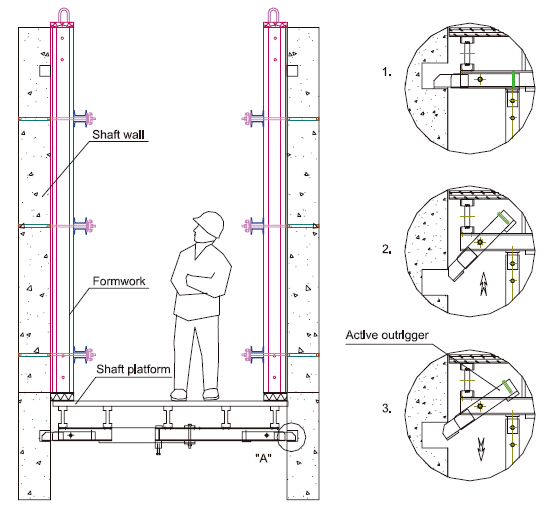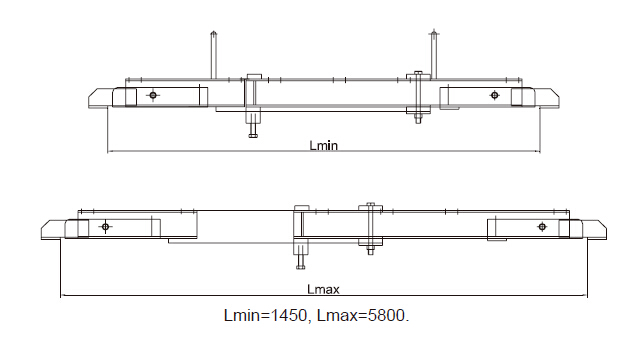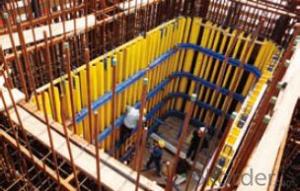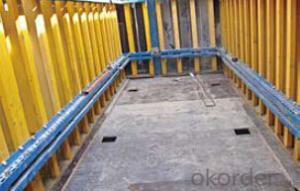Shaft-platform System for Formwork and Scaffolding
- Loading Port:
- Tianjin
- Payment Terms:
- TT OR LC
- Min Order Qty:
- 50 m²
- Supply Capability:
- 1000 m²/month
OKorder Service Pledge
Quality Product, Order Online Tracking, Timely Delivery
OKorder Financial Service
Credit Rating, Credit Services, Credit Purchasing
You Might Also Like
Shaft Platform
As operating platform, the shaft platform is mainly used in the concrete pouring of elevator shaft,
equipment shaft, stair shaft of high-rise building and so on.
Characteristics:
◆ The length of shaft beam is adjustable.
◆ Flexible structure makes lifting easier.


- Q:What are the different types of reinforcement systems used with steel formwork?
- There are several different types of reinforcement systems that are commonly used with steel formwork in construction projects. These systems are designed to provide additional strength and stability to the formwork, ensuring that it can withstand the weight of the concrete and other loads. One common type of reinforcement system is the use of steel bars or rods, also known as rebar. Rebar is typically placed horizontally and vertically within the formwork to create a grid-like structure. This helps to distribute the weight of the concrete evenly and prevent any potential cracks or failures in the formwork. Another type of reinforcement system is the use of wire mesh or welded wire fabric. This is a grid of wires that is typically laid over the formwork before the concrete is poured. The wire mesh helps to reinforce the concrete and provide additional strength and durability. In some cases, steel formwork may also incorporate precast concrete elements as reinforcement. These elements, such as precast beams or columns, are placed within the formwork to provide additional support and reinforcement to the structure. Additionally, some formwork systems may utilize post-tensioning techniques for reinforcement. This involves installing steel cables or bars within the formwork and then applying tension to them after the concrete has been poured. This helps to increase the strength and stability of the formwork and the overall structure. Overall, the choice of reinforcement system will depend on the specific requirements of the project, including the load capacity, design specifications, and desired level of durability. By using appropriate reinforcement systems, steel formwork can be made stronger and more reliable, ensuring the success and safety of the construction project.
- Q:How does steel formwork handle form release agents?
- Steel formwork is highly resistant to form release agents due to its non-porous and smooth surface. This characteristic allows the formwork to efficiently handle form release agents without any adverse effects. The form release agents do not penetrate or stick to the steel surface, ensuring easy removal of the formwork and preventing any potential damage or staining.
- Q:What are the typical corrosion protection measures for steel formwork systems?
- There are several typical corrosion protection measures for steel formwork systems that can help extend their lifespan and maintain their structural integrity. One common method is the application of protective coatings. This can include the use of epoxy coatings, which provide a barrier against moisture and corrosive elements. These coatings are typically applied to the entire surface of the steel formwork system, including any joints or connection points. The coating acts as a protective layer, preventing direct contact between the steel and the surrounding environment. Another measure is the use of galvanizing. Galvanizing involves coating the steel formwork system with a layer of zinc. This process creates a protective barrier that helps prevent corrosion. Galvanizing is particularly effective in environments with high levels of moisture or exposure to saltwater, such as coastal areas. Regular maintenance is also essential for corrosion protection. This includes inspecting the formwork system for any signs of damage or deterioration, such as rust or pitting. Any areas of concern should be addressed promptly, either through repair or replacement. Additionally, regular cleaning and removal of any debris or contaminants can help prevent corrosion from occurring. Proper storage and handling of the steel formwork system is another important measure. The formwork should be stored in a dry, well-ventilated area to minimize exposure to moisture. It should also be handled correctly to avoid any unnecessary damage or scratches, which can compromise the protective coatings. Lastly, the use of sacrificial anodes can be employed as a corrosion protection measure. Sacrificial anodes are made from a metal that is more reactive than the steel formwork system, such as zinc or magnesium. When attached to the formwork, the sacrificial anode corrodes instead of the steel, effectively sacrificing itself to protect the system. Overall, a combination of protective coatings, galvanizing, regular maintenance, proper storage, and sacrificial anodes can provide effective corrosion protection for steel formwork systems, ensuring their longevity and durability.
- Q:Can steel formwork be used for precast concrete arches?
- Yes, steel formwork can be used for precast concrete arches. Steel formwork provides a strong and durable structure for shaping and supporting the concrete during the casting process. It allows for the creation of precise and complex arch shapes, ensuring the desired architectural and structural requirements are met. Additionally, steel formwork can be easily customized and reused, making it a cost-effective option for precast concrete arches.
- Q:Can steel formwork be used for curved or irregular structures?
- Indeed, curved or irregular structures can be constructed using steel formwork. The utilization of steel formwork provides design flexibility and enables the easy shaping or fabrication of intricate geometries. Its strength and durability allow it to endure the immense pressure exerted during the pouring of concrete. With the ability to effortlessly adjust and adapt, steel formwork is well-suited for constructing structures with distinctive architectural designs or intricate layouts that incorporate curves, bends, or irregular shapes. Furthermore, the implementation of steel formwork guarantees a sleek finish to the concrete surface, resulting in structures of exceptional quality and aesthetic appeal.
- Q:Types of building templates? What is clear water template?
- Bamboo plywood template: is the earliest use of plain bamboo plywood template, has developed a bamboo bamboo plywood coated template, bamboo plywood, wood coating or coating bamboo plywood etc.
- Q:How does steel formwork handle high concrete pressures?
- Steel formwork is able to handle high concrete pressures due to its inherent strength and rigidity. Steel is a durable and robust material that has the ability to withstand significant loads and pressures without deforming or collapsing. It ensures that the formwork structure remains stable and secure, even when subjected to the high pressures exerted by the poured concrete. This makes steel formwork an ideal choice for construction projects where high concrete pressures are anticipated.
- Q:How does steel formwork prevent concrete segregation?
- Steel formwork prevents concrete segregation by providing a strong and rigid framework that holds the concrete in place during the pouring and curing process. This prevents the different components of the concrete mixture, such as aggregates and water, from separating and settling unevenly, resulting in a more homogeneous and uniform concrete structure.
- Q:How does steel formwork impact the overall project execution?
- Steel formwork can have a significant impact on the overall project execution. Its strength and durability make it an ideal choice for construction projects, allowing for faster and more efficient work. Steel formwork also provides accurate and precise results, ensuring that the structures are built according to the desired specifications. Additionally, steel formwork is reusable, reducing the overall project costs and minimizing environmental impact. Overall, steel formwork enhances the efficiency, quality, and cost-effectiveness of the project execution.
- Q:How does steel formwork affect the overall productivity of the construction process?
- The overall productivity of the construction process can be significantly influenced by steel formwork. Firstly, steel formwork is renowned for its durability and strength, enabling it to withstand the immense pressure and force exerted by concrete during pouring and curing. This durability ensures that the formwork remains intact and stable, reducing the need for repairs or replacements, thereby saving time and cost. Additionally, assembly and disassembly are made more efficient with steel formwork. Steel panels can be easily connected and detached, allowing for swift and seamless installation and removal. This ease of use ensures that construction can progress at a quicker pace, ultimately increasing overall productivity. Furthermore, steel formwork delivers a smooth and high-quality finish to concrete structures. The precise and rigid nature of steel formwork prevents any deformations or warping during pouring and curing stages, resulting in a superior surface finish. This eliminates the need for additional finishing work, such as plastering or smoothing, thereby reducing the time and effort required for post-construction tasks. Moreover, steel formwork is highly adaptable and can be customized to accommodate various shapes and sizes, facilitating the construction of complex structures with ease. This flexibility allows for greater design freedom and eliminates the necessity for additional supporting structures, ultimately reducing construction time and increasing productivity. Lastly, steel formwork is reusable and can be utilized for multiple projects, unlike traditional timber formwork which often requires disposal after a single use. This reusability not only reduces material waste but also saves time and cost in procuring new formwork for each project. In conclusion, steel formwork significantly enhances the overall productivity of the construction process. Its durability, ease of assembly, high-quality finish, adaptability, and reusability all contribute to faster construction timelines, reduced costs, and improved efficiency, making it a preferred choice for many construction projects.
1. Manufacturer Overview |
|
|---|---|
| Location | |
| Year Established | |
| Annual Output Value | |
| Main Markets | |
| Company Certifications | |
2. Manufacturer Certificates |
|
|---|---|
| a) Certification Name | |
| Range | |
| Reference | |
| Validity Period | |
3. Manufacturer Capability |
|
|---|---|
| a)Trade Capacity | |
| Nearest Port | |
| Export Percentage | |
| No.of Employees in Trade Department | |
| Language Spoken: | |
| b)Factory Information | |
| Factory Size: | |
| No. of Production Lines | |
| Contract Manufacturing | |
| Product Price Range | |
Send your message to us
Shaft-platform System for Formwork and Scaffolding
- Loading Port:
- Tianjin
- Payment Terms:
- TT OR LC
- Min Order Qty:
- 50 m²
- Supply Capability:
- 1000 m²/month
OKorder Service Pledge
Quality Product, Order Online Tracking, Timely Delivery
OKorder Financial Service
Credit Rating, Credit Services, Credit Purchasing
Similar products
New products
Hot products
Related keywords
























